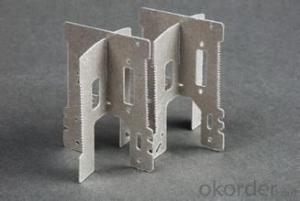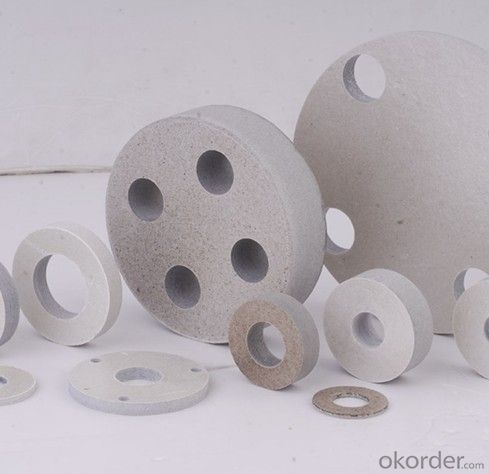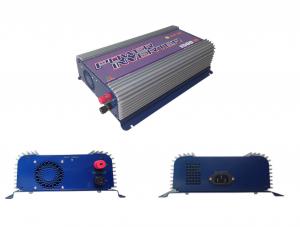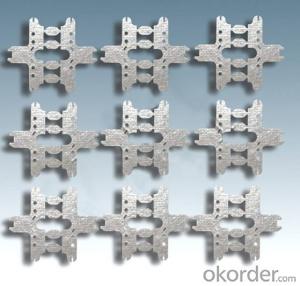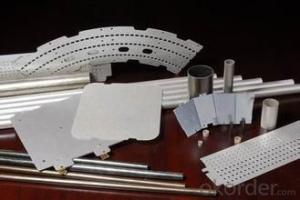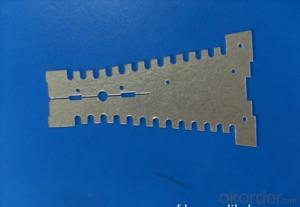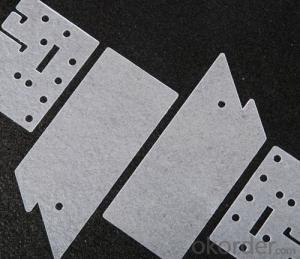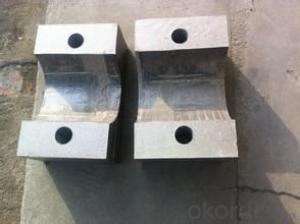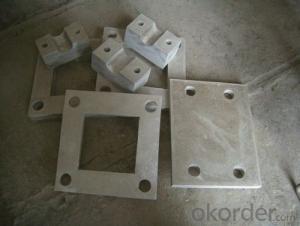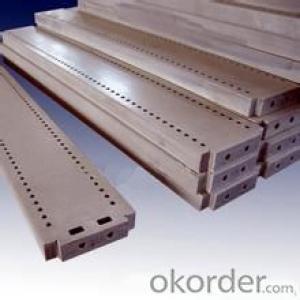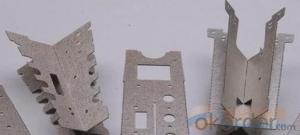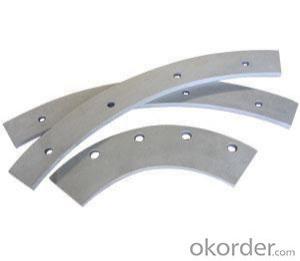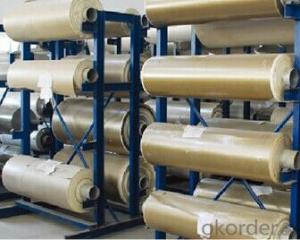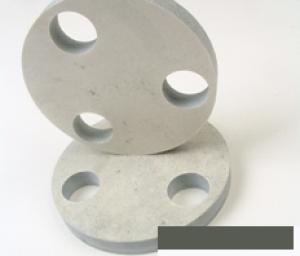Mica Parts Used for Microwave Ovens Industry
- Loading Port:
- Shanghai
- Payment Terms:
- TT OR LC
- Min Order Qty:
- 100 pc
- Supply Capability:
- 10000 pc/month
OKorder Service Pledge
OKorder Financial Service
You Might Also Like
1. Introductions:
Mica plate is made of mica paper with highperformance organic silicon resin. After heating and pressing, the mica plate can be made into rigid or flexible insulating plates. The mica content is about 90% and the organic silicon resin content is 10%.
Mica is a rigid substrate able to withstand very high temperatures and are suited for applications up to 500°F (260°C). Mica heating elements offer several distinct advantages over other flexible heater technologies, including extremely low leakage, lower material costs, and higher operating temperatures. Our mica heating element is made by detail order requirments.
2. Applications:
Typical applications of mica heating elements are air heaters, enclosure systems, food service equipment, process and packaging equipment.
3. Main features of Mica Parts:
Rigid mica plates are featured with high strength, good performance, less smoke, less odor etc.
This series mica plates are used mainly in household appliances (toaster ovens, microwave ovens, warm air blowers, hair dryers, electric iron etc.), metallurgy (such as line-frequency furnaces, medium frequency furnaces, electric arc furnace, etc.), medical equipment and other industries, used as the heating support, lining plate and partition plate of the electric appliances described above.
4. Technical Parameters:
MICA SHEET -----Technical data | ||||||||
ITEM | UNIT | RM | RP | RM-T | RP-T | FM | FP | |
Hardness |
| Rigid | Rigid | Rigid | Rigid | Flexible | Flexible | |
Mica paper |
| Muscovite | Phlogopite | Muscovite | Phlogopite | Muscovite | Phlogopite | |
Thickness | mm | 0.1-2.0 | 0.1-2.0 | 3.0-50 | 3.0-50 | 0.1-2.0 | 0.1-2.0 | |
Mica content | % | ≥90 | ≥90 | >88 | >88 | ≥90 | ≥90 | |
Bond Content | % | <10< span=""> | <10< span=""> | <12< span=""> | <12< span=""> | <10< span=""> | <10< span=""> | |
Density | g/m 3 | 1.6~2.45 | 1.6~2.45 | 2.1~2.4 | 2.1~2.4 | 1.6~2.45 | 1.6~2.45 | |
Heat | Continuous | ℃ | 500 | 700 | 500 | 700 | 500 | 700 |
Peak | ℃ | 700 | 900 | 700 | 900 | 700 | 900 | |
Heat loss at 500℃ | % | <1< span=""> | <1< span=""> | <1< span=""> | <2< span=""> | <1< span=""> | <1< span=""> | |
Heat loss at 700℃ | % | <2< span=""> | <2< span=""> | <1< span=""> | <2< span=""> | <2< span=""> | <2< span=""> | |
Flexural strength | Mpa | >160 | >140 | — | — | <1< span=""> | <1< span=""> | |
Water absorption 24h/23°C | % | <1< span=""> | <1< span=""> | <1< span=""> | <2< span=""> | — | — | |
Dielectric strength | KV/mm | >20 | >20 | >15 | >15 | >15 | >15 | |
Volume | 23℃ | ΩNaN | >1017 | >1017 | >1017 | >1017 | — | — |
500℃ | ΩNaN | >1012 | >1012 | >1012 | >1012 | — | — | |
Smoking Test | s | <4< span=""> | <4< span=""> | — | — | — | — | |
FAQ
We have organized several common questions for our clients,may help you sincerely:
--------What is the use of mica parts?
Mica laminate and washers made of our own high quality mica plates are used for home appliances, electro-magnets, micro-sensitive control gear etc
---------Which type of mica parts we can produce?
1. Rigid mica parts or Flexible mica parts
2. Muscovite mica parts or phlogopite mica parts
3. Thin mica parts or thick mica parts
4. All the special sized mica parts need drawing.
----------what advantages of mica parts?
1. Good high voltage insulation materials
2. Do not easily break up
3. Easily produce special size
- Q: What is the electrical performance of insulating materials
- Insulation material electrical performance mainly refers to: good dielectric properties, high insulation resistance and compressive strength. Do not occur leakage, creeping or breakdown and other accidents. Good heat resistance performance in the long-term heating state no significant change in performance. Good thermal conductivity, moisture resistance and mildew resistance.
- Q: There are a lot of online about this, but still do not understand. If the insulation resistance is high enough, hit the pressure should also be qualified ah. There is insulation test itself when the current flow is not large, because the rock table resistance is great. But hit the pressure, I do not know is not a direct high pressure drop in the test product above, there is no great resistance to interference?
- Insulation test Because the test voltage is low, it is not easy to damage the equipment under test. The voltage test is easy to damage the equipment under pressure when the test voltage is high. In some cases, although the withstand voltage test is passed, Causing damage, the test staff will have to use low-voltage insulation test, test the pressure test after the test equipment insulation. Under normal circumstances, insulation resistance qualified, withstand voltage test will be adopted.
- Q: What kind of insulation is the insulating
- Now most of the aluminum substrate in the insulating layer or epoxy (I do this, do not mention my company name, so that I advertise). Epoxy can be modified, and then through the surface treatment of the thermal filler, in the cross-linked when the formation of a most conducive to the heat transfer structure, so as to achieve the purpose of high thermal conductivity.
- Q: What insulating materials are used for transformers
- With the largest number of cardboard, as well as laminated wood, insulating paper, transformer oil, large oil-immersed transformers are mostly oil - paper insulation.
- Q: What is the insulating material in the middle of the connecting wire?
- Looked for a long time to understand your problem, I can see with a relatively thin tube into the insulation, the insulation tube into a plug in the insulation of the skin. Or for the wire, without the foreskin of the wire is not safe
- Q: What is the DMD insulation material?
- These small mirrors are approximately 16 or 14 microns in size and are usually made up of an array of up to 50 to 2 million, with a gap between the mirrors of 1 micron and a mirror rotating with an aluminum hinge as a rotation axis 10- 12 degrees, can be used repeatedly 1 trillion, life test shows that in accordance with the usual use can be used for 100,000 hours. Its opening and closing control is through the mirror stop when the damping effect of the spring contact near the mirror, gradually reduce the way the additional voltage to achieve. DMD chip has been upgraded, the original chip on the microscope size of 16 microns, flip angle of 10 degrees, the current DMD micrometer size of 14 microns, flip 12 degrees, support 4K resolution chip has also been formed, the chip size of about 1.38 Inch.
- Q: Wear-resistant, high temperature, insulation materials which
- Epoxy, temperature from 100-400 degrees, processing more convenient. Ceramic is the best and cheap.
- Q: What is the thermal aging and electrical aging of insulating materials?
- Insulation materials in electrical equipment during the operation, due to the long-term effects of various factors, there will be a series of irreversible physical and chemical changes, resulting in its electrical performance and mechanical properties decline, commonly known as aging. There are many factors that affect the aging of insulating materials. The main aging forms are environmental aging, heat aging and electrical aging.
- Q: What are the electrical insulation materials
- Insulation board: plastic plate is made of plastic sheet, plastic for the synthesis of polymer compounds, can be free to change the body style. Plastic is the use of monomer raw materials to synthesis or condensation reaction polymerization of materials, synthetic resin and filler, plasticizers, stabilizers, lubricants, colorants and other additives, and its main component is synthetic resin.
- Q: What insulating material is best `?
- According to their polarity is divided into weak polarity, non-polarity, polarity and strong polarity 4. According to the material source is divided into mineral insulating oil, synthetic insulating oil and vegetable oil 3. Mineral insulating oil referred to as mineral oil, The relative dielectric constant is about 2.2, and the breakdown voltage in the standard electrode is 35 to 50 kV (kV). The flash point is 125 to 135 ° C for the manufacture of transformers and cables , Capacitors, etc. Synthetic insulating oil is a synthetic liquid insulating material.As the mineral oil is a mixture of various hydrocarbons, it is difficult to remove the components of the insulation performance, and the preparation process is complex, easy to burn, low heat resistance , The dielectric constant is not high, so the research and development of the excellent performance of the synthetic insulating oil. Now have used aromatic synthetic oil, silicone oil, ester oil, ether and sulfone synthetic oil, polybutylene, etc. Vegetable oil use Castor oil, soybean oil, rapeseed oil, etc. Castor oil is an excellent dip capacitor for pulse capacitors
Send your message to us
Mica Parts Used for Microwave Ovens Industry
- Loading Port:
- Shanghai
- Payment Terms:
- TT OR LC
- Min Order Qty:
- 100 pc
- Supply Capability:
- 10000 pc/month
OKorder Service Pledge
OKorder Financial Service
Similar products
Hot products
Hot Searches
Related keywords
